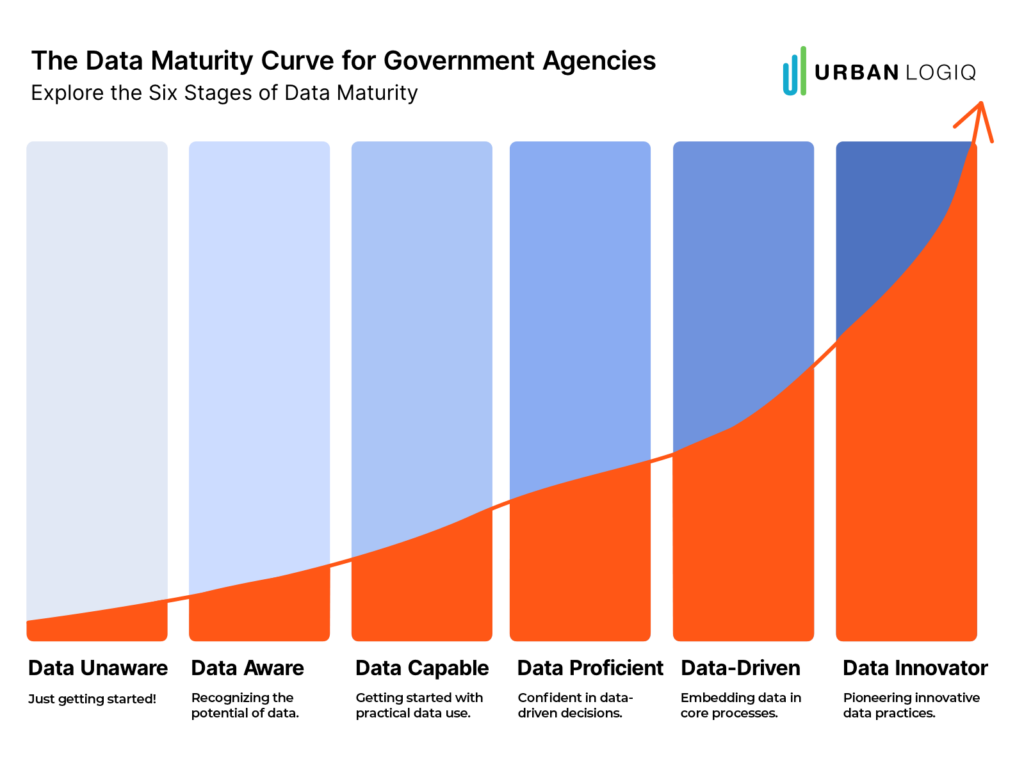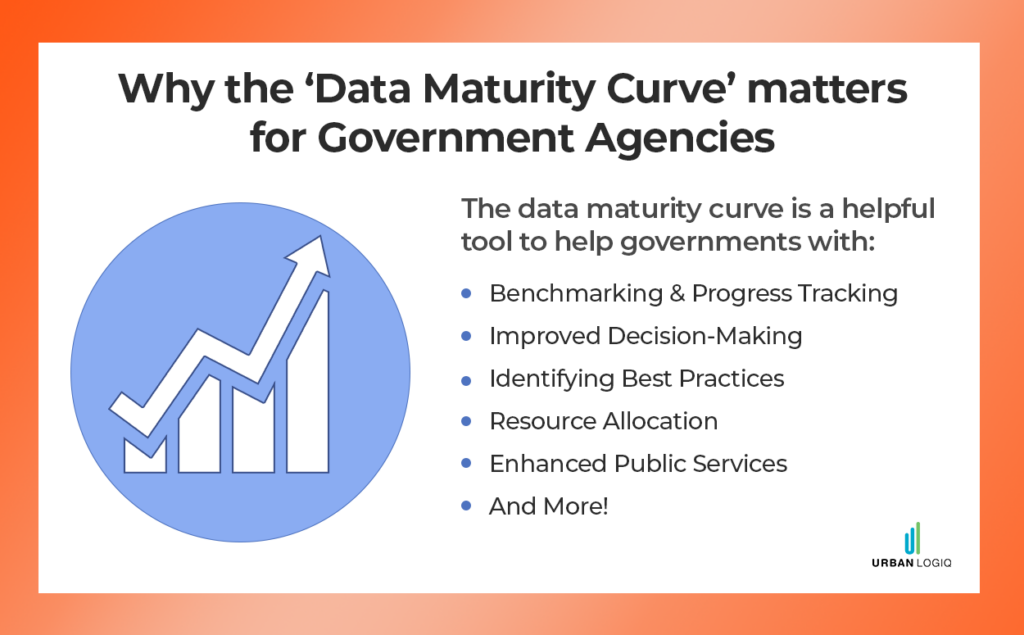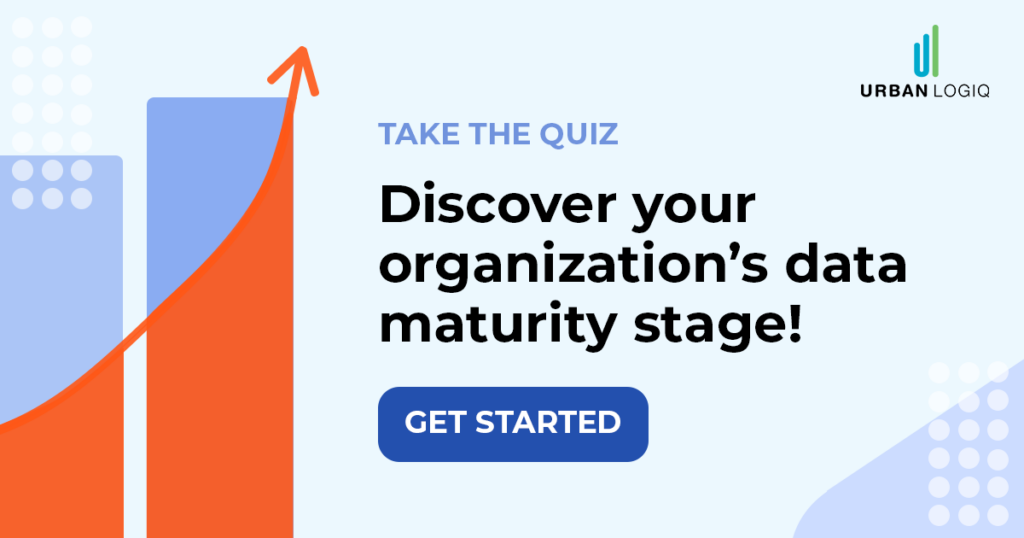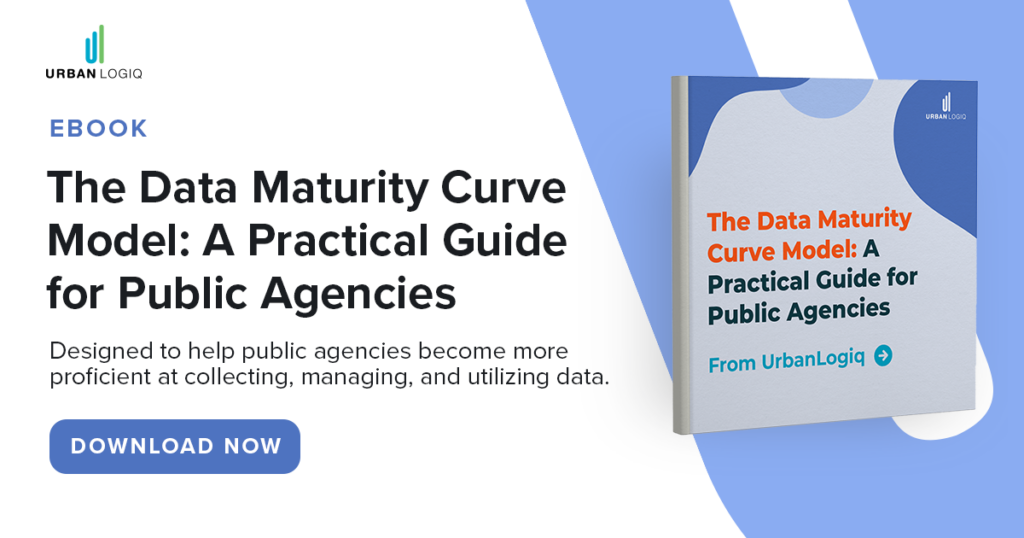The Data Maturity Curve for Government: A Quick Guide

Data is an invaluable resource in the toolkit of modern government agencies. It plays a pivotal role in shaping policies and guiding decision-making. However, factors such as an agency’s size, budget, and available resources heavily influence the ability to leverage data effectively. These factors vary significantly from agency to agency. That’s where the concept of data maturity comes into play.
Just as one learns to ride a bike – starting with training wheels and gradually mastering the skill to navigate more challenging terrains – government agencies also embark on a journey with their data. They start with fundamental data capabilities, and as their skills mature, they evolve toward handling more complex data operations. The progression along this journey is what we refer to as the ‘data maturity curve.’
In this blog, we’ll guide you through various stages of the curve, from basic to advanced levels. Understanding an agency’s position on this curve is helpful because it serves as a roadmap for navigating the evolving journey of data proficiency. Additionally, we will shed light on how each level of data proficiency impacts business outcomes, highlighting the close connection between data proficiency and smarter decision-making, streamlined operations, and improved service delivery.
What is Data Maturity?
Data maturity is a helpful concept for modern organizations striving to harness the potential of their data. In simple terms, data maturity refers to how well an organization can collect, analyze, and apply data for informed decision-making. It encompasses not only the quality, completeness, and accessibility of data but also how it’s managed and analyzed. Think of it like having a toolbox with the right tools and knowing how to use them effectively. Both parts, the quality of data and how it’s managed and analyzed, are super important for modern organizations to make the most of their data and make effective decisions.
What is the Data Maturity Curve?
The data maturity curve is a framework that helps organizations assess and improve their data management and analysis capabilities. There are six stages, each representing a different level of maturity. They reflect how well a government collects, manages, and uses data for decision-making, policy formulation, and service delivery.
Take our short data maturity assessment quiz. No judgments, just insights!
Stages of the Curve
Within government, we have identified the six key data maturity stages below:
1. Data Unaware
Where it all begins! At this stage, an agency lacks formal data management processes and has limited awareness of data importance. Consequently, data may be scattered across systems or spreadsheets, lacking standard protocols for collection, organization, or analysis. Staff primarily rely on intuition and experience for decision-making.
💡 What is data management? Data management refers to a series of processes that outline how an organization should manage its data!
2. Data Aware
At this stage, the organization acknowledges the value of data and recognizes the need for improved data management practices. However, they may lack the infrastructure, policies, or resources to manage and use data effectively. Data collection is inconsistent and the extent of data-driven decision-making is limited.
3. Data Capable
At this stage, the organization actively invests in data infrastructure, tools, and skills. However, data-driven decision-making remains sporadic or limited. The organization actively practices more consistent and standardized data collection, storage, and management. Advanced analytics have not yet seen widespread adoption.
4. Data Proficient
At this stage, the agency has implemented a more formal and well-defined data strategy and data management process. Dedicated staff may organize and analyze data, and the agency may actively invest in data analytics tools and technologies. The agency actively explores data analytics and visualization tools to identify patterns and trends in the data.
5. Data-Driven
At this stage, the agency has established a comprehensive data management program. They treat data as a strategic asset, with clear governance policies in place to ensure data quality and accuracy. Decision-makers at all levels of the organization use data at the core of their decision-making. Moreover, data is made more accessible and understandable through visualization and analytics tools. The agency also employs advanced analytics, predictive modeling, and machine learning.
6. Data Innovator
The final stage! The organization has comprehensive data governance and innovation policies in place. Moreover, data insights fully drive decision-making. The organization has a state-of-the-art data collection program including the use of big data, IOT data, or connected vehicle data. In addition, they lead in innovative data solutions and are a thought leader in data-driven governance. The organization embraces cutting-edge data technologies and methodologies, driving innovation in areas such as AI and IoT.
Want to dive deeper into each stage? Our eBook highlights key stage characteristics, KPIs, and milestones.
The Importance of Data Maturity in the Public Sector
Data maturity is increasingly crucial in the public sector. The ability to effectively collect, manage, and utilize data can revolutionize the way public institutions operate, making them more efficient, equitable, and responsive to the needs of the citizens they serve.
A higher level of data maturity can not only improve decision-making and efficiency but also increase accountability and transparency. Governments investing in their data maturity are investing in their future and improving their ability to adapt to changing needs.
As such, the Data Maturity Curve is a valuable tool that can help agencies in a number of key ways:
Benchmarking. The data maturity curve serves as a benchmark, helping agencies assess their current capabilities and track their progress over time. Additionally, it helps them note future milestones.
Improved Decision-Making. As government agencies move up the data maturity curve, they are able to make more informed and strategic decisions. As a result, data and insights drive decisions rather than just intuition or guesswork. This can improve outcomes and increase efficiency.
Identifying Best Practices. Governments can identify best practices and strategies by studying successful agencies further up the curve. These insights can help them improve their own capabilities.
Resource Allocation. Knowing their position on the maturity curve can assist agencies in pinpointing areas where they should allocate additional resources. This may be in data collection, data management systems, analytics tools, or staff training.
Enhanced Public Services: Ultimately, the aim of increasing data maturity is to improve public services. Better use of data can lead to more effective and responsive services, meeting citizens’ needs more effectively.

Benefits of measuring data maturity in government
Case Study: Strategies and Success Stories from the Texas Department of Transportation (TxDOT)
Managing data across TxDOT’s 25 geographical districts presents a significant challenge. To address local issues effectively, the expansive state has been segmented into manageable regions. However, this approach led to each TxDOT district generating its own unique data, creating data silos.
In a recent episode of our ‘Ask The Experts’ series, we delved into the journey of advancing data maturity within the Texas Department of Transportation (TxDOT). Our guest, David Tidwell, who formerly served as the Traffic Safety Division Systems Support Branch Manager, shared his experiences in breaking down data silos and enhancing data access and management across districts. He also provided valuable insights into overcoming common obstacles and implementing effective strategies to guide any agency toward improved data proficiency.
Here are some key takeaways from his insights:
- Collaboration, open communication, and shared goals among all data stakeholders are paramount for advancement.
- Building a dedicated team that values data-driven approaches is essential.
- Improving access to clean, structured data across the organization helps reduce data silos.
- Cultivating strong relationships with individuals, departments, and data creators, including vendors, who often possess invaluable knowledge.
- Promote a culture of shared responsibility and knowledge transfer.
- Nurture strong relationships throughout your organization to help you circumvent resistance to change.
- Setting small, measurable goals that align with your agency’s objectives is a practical approach.
Advancing TxDOT’s data maturity is an ongoing mission. As Tidwell aptly puts it, “this is not an overnight solution. It’s a marathon, not a sprint.” He advises against aiming for significant wins right away; instead, focus on measurable and attainable goals.
For further insights from David Tidwell, we encourage you to watch our video below.
Ask The Experts: Data Maturity with David Tidwell, TxDOT
A Journey of Continuous Improvement
The data maturity curve is a helpful framework for governments to improve their data proficiency. By pinpointing their stage on the curve, governments can make more informed decisions and identify goals and benchmarks. This, in turn, helps them increase efficiency and improve the quality of their citizen services.
Remember, advancing to the next level of data maturity is a journey, not a destination! It requires ongoing effort and investment in people, processes, and technology. The commitment to fostering a data-driven culture, refining data management practices, and adopting cutting-edge technologies remains an ongoing imperative.
About UrbanLogiq
UrbanLogiq’s mission is to break down data silos and help government agencies make the most out of their existing data. Our easy-to-use data platform creates one common operating picture of a community. This empowers public officials to make data-driven decisions faster and cheaper than traditional methods. We work with agencies ranging from municipalities under 100,000 in population, to regional governments, states and provinces, and many agencies in-between. Book a 30-minute demo today!
Our Story: https://youtu.be/hmp-eRd8OUg




